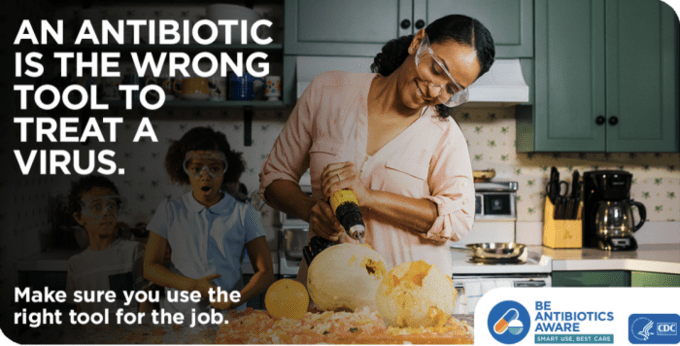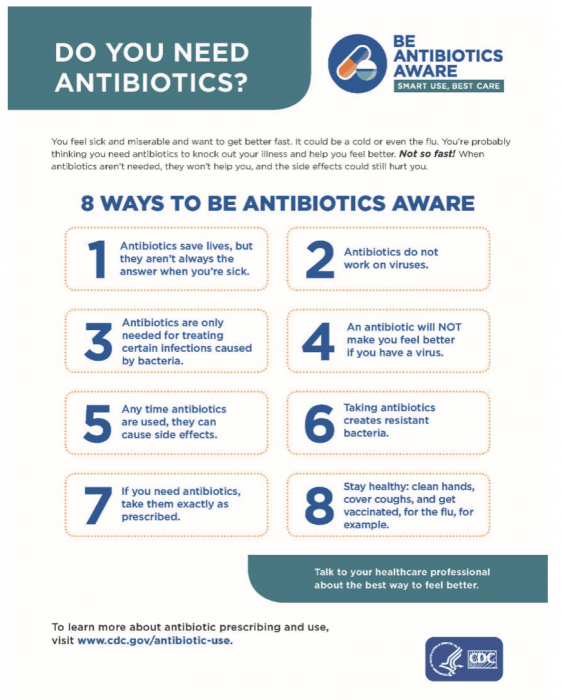This post may contain affiliate links. Please read our disclosure policy.
This is a post prepared under a contract funded by the Centers for Disease Control and Prevention (CDC) and written on behalf of the Mom It Forward Influencer Network for use in CDC’s Be Antibiotics Aware educational effort. Opinions on this blog are my own and do not necessarily reflect the views of CDC.
The Truth About Antibiotics
Do you know the story of the boy who cried wolf? There is a little shepherd boy who repeatedly tricks nearby villagers into thinking wolves are attacking his flock. He calls “Wolf!” and the villagers always come to help him, but they soon find that there is never a wolf.
When a wolf does appear and the boy again calls for help, the villagers believe that it is another false alarm, and the sheep are eaten by the wolf.
This is how we need to think of antibiotics. We overuse them so much that when we really do need them, they may not work. That’s because whenever we take antibiotics, resistant bacteria are created. Antibiotic resistance occurs when bacteria develop the ability to defeat the drugs designed to kill them. What does this mean? It means that if we don’t improve our use of antibiotics, they may not work. The illness will win … the wolf will get the flock.

Why is antibiotic resistance a threat?
Antibiotic resistance is one of the most urgent threats to the public’s health. Each year in the United States, at least 2 million people get infected with antibiotic-resistant bacteria. At least 23,000 people die each year as a result. That’s a scary statistic.
Antibiotics aren’t always the answer
Did you know that about 50 percent of all antibiotics in U.S. outpatient settings are prescribed incorrectly (the wrong antibiotic, at the wrong dose, for the wrong length of time, or at the wrong time)? In fact, patients sometimes ask for or expect antibiotics from their healthcare professionals, even when their illness is not caused by bacteria, because they think the antibiotic will help them feel better quicker and/or stop their illness from getting worse. But that’s incorrect.
Most people think that if antibiotics worked in the past for a similar illness, they’ll work next time they’re sick. But, often people don’t know that their condition is caused by a virus and antibiotics won’t help them.
Be informed
Be Antibiotics Aware helps patients and families understand that antibiotics do not work on viruses that cause colds and flu, bronchitis, or runny noses, even if the mucus is thick, yellow, or green.
Respiratory viruses usually go away in a week or two without treatment (“It will go away in 7–10 days,” as my mom reminds me when I have a cold). Ask your healthcare professional about the best way to feel better while your body fights off the virus.
I think this is such a common misconception, so I’m glad that Be Antibiotics Aware is helping educate families on this fact.
When antibiotics aren’t needed, they won’t help you, and the side effects could still hurt you. Side effects range from minor to very severe health problems, such as a rash or C. difficile (C. diff) infection. When you need antibiotics for an infection, the benefits of the drug usually outweigh the risk of side effects.
Antibiotics save lives. They are critical for treating people with serious infections, such as pneumonia or sepsis, the body’s overwhelming response to infection.
This is why it is so important to educate others about when antibiotics are needed. If you need antibiotics, take them EXACTLY as prescribed (e.g., finish the medication). It’s also important to talk with your doctor if you have any questions about your antibiotics.
Tip → Use a permanent marker and make a chart right on your prescription bottle. This has saved us SO much confusion in our house. We do this with every single prescription (even mine) because when you are taking care of six people, you tend to lose track of who took what and at what time. This is especially helpful on medication that lasts for several days.
Stay healthy
Remember, you can stay healthy and keep others healthy by cleaning hands, covering coughs, staying home when sick, and getting the recommended vaccines—for the flu, for example. Be your best advocate. Educate yourself on how to best take care of you and your family, with the right tools, medications, and preventive measures.
Improving the way we take antibiotics helps keep us healthy now, helps fight antibiotic resistance, and ensures that lifesaving antibiotics will be available for future generations.
To learn more about antibiotic prescribing and use, visit www.cdc.gov/antibiotic-use.
To learn more about sepsis, a life-threatening condition that is treated with antibiotics, visit www.cdc.gov/sepsis.















